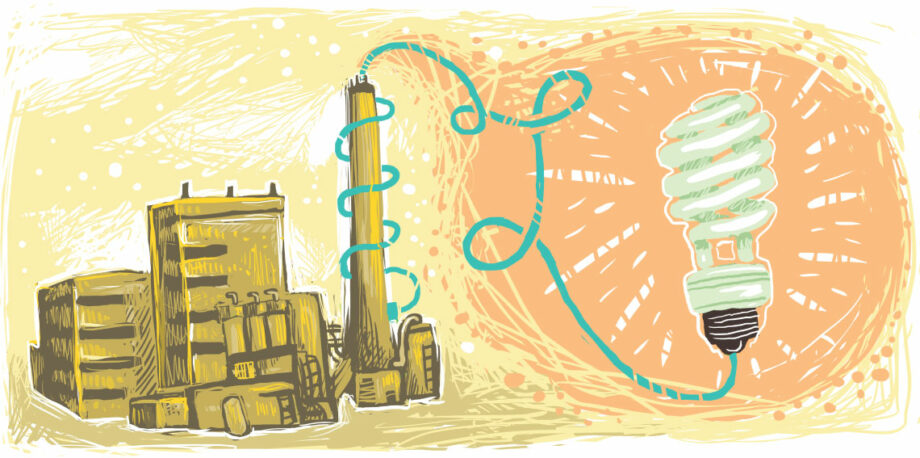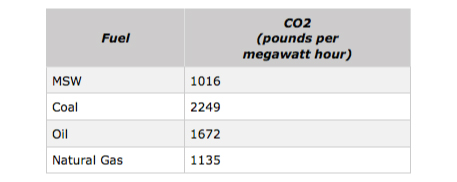Next, no municipality gets 100 percent recycling participation. Post-recycled trash still contains millions of tons of metals that are sent to landfills. At a WTE facility, those metals are automatically captured and recycled by the facility as a part of its normal post-combustion filtration process. This saves the time, materials, energy, emissions and environmental disruption of mining for an equivalent amount of new minerals. The WTE operator Covanta Energy recycled 415,000 tons of ferrous metals and 16,800 tons of nonferrous metals in 2012 alone — enough steel to build 28 Brooklyn Bridges and enough aluminum to produce more than 1 billion beverage cans.
The aluminum that is reclaimed by WTEs from the already post-recycled waste is particularly important. Recycling one ton of aluminum prevents a whopping 13.7 tons of GHG emissions, compared to 4.3 tons for 1 ton of office paper and 2.5 tons for newspaper. Recycling a ton of ferrous metal prevents 1.7 tons of GHG emissions. None of this is recaptured when a truck tips its load into a landfill.
Additionally, WTE facilities are sited close to where waste is generated, in or near urban areas. This eliminates much of the carbon emitted by hauling waste to a distant landfill. In 2011, New York City spent more than $300 million transporting its trash by train and truck — roughly 12,000 tons per day — to landfills as far as 300 miles away, emitting tons more carbon and wearing down roads and vehicles in the process. In some cases, the U.S. is now even exporting its waste to developing countries, vastly compounding its carbon contribution.
The high temperature of WTE combustion completely destroys the chemicals, rendering them inactive and ensuring cleaner lakes, rivers and water supplies.
WTE facilities also generate heat and electricity, avoiding the burning of fossil fuels for those same purposes. For example, the Minneapolis WTE facility currently generates enough electricity to power 25,000 homes, and enough steam to heat 1,500. Their proximity also means less heat and electricity are lost in transport. And, according to EPA studies, burning municipal solid waste in WTEs emits less CO2 per megawatt-hour than burning fossil fuels, including natural gas. New gasification technologies coming online promise even greater energy capture and lower emissions than WTE incineration.
Cleaning up U.S. Lakes and Rivers
Leachate is a hazardous tea created when rain percolates through garbage. Landfills capture this leachate and pump it to a treatment facility, where pollutants are removed through biological and chemical processes before it is discharged into public waterways. But these treatment facilities rarely have the expensive reverse osmosis filters necessary to capture pharmaceuticals and other bioactive chemical products. These agents are turning up in groundwater throughout the U.S. and polluting even remote lakes and rivers. Their presence affects fish and other aquatic species, and they are now found in several municipal water supplies that are drawn from waters polluted with pharmaceuticals.
WTE facilities provide a safe way to destroy pharmaceuticals and other bioactive chemical products that are otherwise disposed of in landfills or that people flush down the toilet. The high temperature of WTE combustion completely destroys the chemicals, rendering them inactive and ensuring cleaner lakes, rivers and water supplies, and fewer pharmaceuticals and bioactive agents entering the food chain and affecting public health.
Time For a Change
So with all these benefits — efficiency, clean energy, reduced greenhouse gases, reduced transportation and road repair, reduced mining, freeing land space otherwise lost to landfills, protecting groundwater and public waters, keeping the food chain cleaner, recycling metals — why haven’t U.S. liberals, who control the politics in many metropolitan areas where WTEs should be built, been supportive of them as they have been in Europe? The answer lies in the history of the American public’s views toward science.
Suspicion of corporations and of hidden dangers to health or the environment have become core, and often unquestioned, assumptions of the liberal U.S. politics that grew up with environmental science and the environmental movement. But these days there is a growing rift between the science and the movement in areas related to energy, climate and waste management. While liberals are justified in their concern about the hidden dangers that pollution can pose, in the case of WTE plants that view has not kept up with the times. This has led to policies that are less effective than those in other countries when it comes to managing waste and fighting climate change.
It’s time for a change. American liberals and environmentalists who care about climate change need to reexamine the science and get behind expanded recycling and WTE programs. Fortunately for the sake of our children, a few bold leaders are starting to do just that. ![]()
Editor’s note: The views expressed here are those of the author and not necessarily of Ensia. We present them to further discussion around important topics. We encourage you to respond with a comment below, following our commenting guidelines, which can be found here. In addition, you might consider submitting a Voices piece of your own. See Ensia’s “Contact” page for submission guidelines.
Ensia shares solutions-focused stories free of charge through our online magazine and partner media. That means audiences around the world have ready access to stories that can — and do — help them shape a better future. If you value our work, please show your support today.
Yes, I'll support Ensia!


Sincerely, Susan Hubbard
Nothing Left to Waste
Sincerely, Jon Foley
Garbage is burned in modern power plants all over the Minnesota after processing and resource recovery for a uniform fuel that allows for the use of modern MACT standards of which Otto writes; even so, they are not located in the middle of metropolitan areas as HERC is.
Why is the discussion always having a Tabu on "reducing" - is it because it doesn't really fit into the capitalistic model of "Take-Make-Dispose" and the strive for infinite Growth. The waste-pyramid seems to always "kind of" start at recycling...
http://sorenandersson.com/incinerating-resources-is-there-any-excuse-for-it/
Think about the emissions from a '57 Chevy versus a modern automobile; both have controls, but saying the crank case ventilation of the Chevy, it's MACT standard if you will, is equivalent to what is done to deal with automobile pollution today is ridiculous and that is what you are doing with HERC.
Expecting any municipality to accept increased emissions given the fact that there are alternatives, and they do exist for a price (regardless the 'just so' statements above), is pretty wack; folks posting here can run a few numbers as well, but the numbers that matter to Hennepin County and Covanta are the new tipping fees for those extra tons of garbage to burn.
Without state and federal subsidy, FTE would just go away on its own. Asking any locals to join in that subsidy (through health care expense incurred by needless exposure to particulates formed after all controls) is ridiculous.
Mr. Otto is simply a shill for Covanta and Hennepin County and substituting "liberal" for NIMBY and spouting pseudoscience and techno speak does not make a case for anything but his own irrelevance.
If you want to get rid of garbage, you stop producing it for once you have it, you have to pay to deal with it. WTE is not something we can afford.
I get arguments from folks, but if you have to go in this direction, plasma arc gasification makes the most sense with use of all of the fuel made and energy released as possible, not some worked over tech from half a century ago (HERC).
Personally, if we are to have metropolitan facilities, they should be plasma gasification, not incineration, as together with reduction, reuse and recycling efforts, pollution of surrounding areas is far less of a concern with this technology.
I'll say it yet again: HERC is the past and I don't need to visit it to know it. I've studied this tech extensively and there is no way to improve it, although you can try to tighten up control of what gets burnt (hard task). If you have control of fuels, then I accept that controls can make things relatively safe, but to pretend that we can do this at HERC is, again, ridiculous.
I am most encouraged by your recent article in the Huff Post regarding Waste to Energy (WTE) plants. In the mid-1970's I was employed by The 4th Sink Management Group, a WTE planning firm. As far as I know, we were the first consulting firm to provide a statewide strategy for the full recovery of municipal solid waste. When "progress reports" such as your article appear, I am more than nostalgic. I am as frustrated as I was when we delivered a copy of that statewide strategy to an upper level civil servant of the state. He held it for a moment...and then tossed it into the trash by his desk. He tossed it away because he was in charge of state-wide landfill inspections. Landfills are as obsolete now as they were in the 1970's and WTEs remain as the only economically and ecologically viable alternative. Greenhouse gases were not considered in the mmid 1970s. we spoke of only "leachate" and "air quality". I submit that to draw attention to the total cost of wasting-away our planet, a new chart of cost accounts has to be mandated, beyond the current environmental reviews, that accounts for the unbridled theft, in dollars amounts of public air, water and land. These 3 are known as "engineering sinks" that profiteers have used at no private cost. The private and public economies, the 4th and final "sink", must be placed in the ecological-economic equation . A publically regulated and total account of the ecological costs and benefits of landfills vs. WTEs is needed to avoid the legacy of a planetary disaster selfishly passed on to our children and grandchildren. Corporations must be taxed for the damage done, and yes, we must all pay now or pay much more later.
"Allowable" levels of pollutants always beg the question of how much is OK. If it is not OK to push mercury into the atmosphere, then it is not OK. Smaller amounts mean we are going to die more slowly. So to argue that a reduction of 97% of mercury is good ignores the other 3%, which, if you live close to one of these facilities, is 3% too much.
Fact is, our waste stream is not designed to have any useful end life. It is not seen as the manufacturer's responsibility to worry about how it is to be recycled, incinerated or dumped in a land fill. Without this design consideration, incineration will always be a mug's game, forcing extra expense into the process to deal with this failure of design and responsibility.
At the same time I am sure that the data on final CO2 equivelant numbers from in incineration vs landfill are correct, and I am equally sure that with all the flack that the incineration business gets, the industry has improved to a much greater degree than the coal electric industry has, making discussion of relative mercury levels frustrating for advocates of incineration.
Two things here: one, allowable levels of contamination are often stupid in terms of prevention of toxins from entering the environment and need serious questioning and review.
Two, these facilities are expensive and tend to have their own momentum as time moves forward, locking us into a product to waste paradigm that is destructive as well. Looking forward we are much better off making a leap to eliminating the concept of waste: products designed so that waste equals food for biological or industrial processes, and actually making landfills and incineration illegal.
Otherwise it is just a wrinkle on the same issue.
Reality? Spending on LEEDS buildings is becoming illegal for many state governments, Kansas is passing a law to make state spending on any sustainable initiative illegal, and the infinite growth maniacs are in charge of way too many corporations and governments.
So, good luck.
Andrew spearheaded the Hennepin Energy Recovery Center incinerator that Otto uses as an example here and Andrew insists to this very day that it is 'green' as it must be perceived if he is to win a Minneapolis Democratic Farmer Labor Party endorsement for mayor this Saturday.
The piece is so full of 'truthiness' and ignorance of the different technologies in use by various members of the 'waste to energy' cult that it is hard to believe that anyone could take it seriously.
Otto should stick to fiction as he is better at it; come to think of it, he has; I don't know if Andrew and other WTE folks should glad for it or not.
In the overall picture of environmental risks, municipal solid waste incineration ranks very low compared to the effects of our automobile-centric transportation system, our coal and fossil fuel-based energy system, and other non-point sources like recreational fires, burn barrels, gas stations, etc. (see my article in the peer-reviewed scientific journal Risk Analysis for documentation). It seems to me that the place to focus our concerns and efforts are on the sources causing the most damage to our health.
The Europeans confronted the waste-to-energy dilemma in the 90s and made a conscious decision to use well-controlled waste-to-energy as a component of their waste management system. It is imperfect, but by general concensus it is better than landfilling. Perhaps one day businesses will sell only products that are completely reuseable and recyclable, and everyone will participate in the process of reusing, composting and recycling, but that day is not yet near.
Neil Seldman, Institute for Local Self-Reliance
This starts with regulating the chemistry in product packaging (Grunpunkt+), then having effective waste collection in every venue people congregate and consume, then having effective composting and recycling to "purify" your WTE feedstock, this includes separation machinery and human labor. The WTE system itself then needs to have effective pollution controls, and a responsible ash management solution.
No WTE proposal I've seen in the US wants to do the job right.
My question concerns the methane emission rates from landfills. You link to an EPA document related to the development of their Waste Reduction Model (WARM), which gives estimated fractions of waste entering landfills with different types of methane recovery. As I interpret the document, and I may be in error on this, the estimates are for how much of each type of landfill at present. This includes waste landfilled many years ago, in very old landfills, which would not have good LFG recovery or power generation. Many of these older sites are probably no longer accepting new material and may even be covered over.
If one were to landfill a ton of organic matter today, it would be more likely to go in a newer landfill, which would be more likely than the rates you cite to have LFG recovery.
Essentially, it seems like you're basing your methane emission calculations on the average landfill technology mix, whereas the actual rate of emissions for waste landfilled today would depend on the marginal landfill technology mix, which is likely to release substantially less methane.
I doubt this is enough to cause a significant change in your conclusions, but it's worth clarifying.
It'll probably be dismissed as another ad hominem attack, but I have lost any respect that I once had for Greg Pratt.
There is no way to make burning anything low impact enough not to worry about resulting pollution wherever in the world this is done. Pratt knows this, I am certain, but I don't expect him to admit it.
On our way to zero waste, we must use technology that deals with the capacity of human beings to follow through on any method, i.e., it must be close to fool proof.
The economics of a relatively primitive WTE plant like HERC or the marginally better incineration done when trash is processed to recover some of recyclables and hazardous materials, work better than more modern tech, but if the goal is to reduce landfilling and allow the methods of reduction, recycling, reuse and composting to catch up, then the more expensive and cleaner methods of dealing with waste make more sense.
Folks who dismiss factual arguments as ad hominem attacks are not to be believed.
The process is also simple to understand. It eradicate pollutant and odor almost zero. How the smoke goes through a condenser
called E.A.S.T. inside the condenser
the smoke is transform into ash or
tar or substance that can be collected and use. No smoke no pollution. We hope this technology
can help in solving trash problem.
Email us for more information and video. jubeck@yahoo.com , fordeal76@yahoo.com